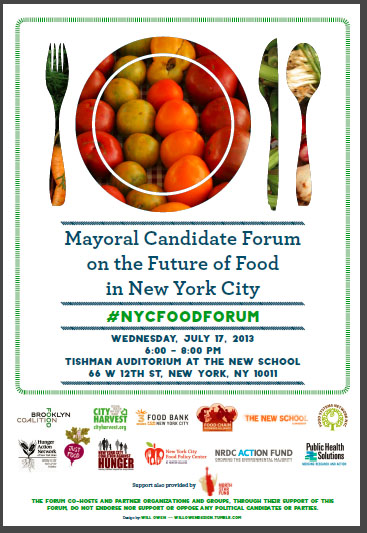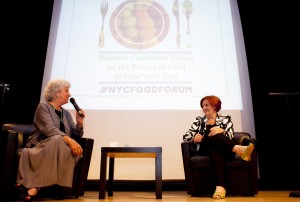By Johanna Goetzel and Jody Dean
The Bloomberg administration is coming to a close and the search for a new mayor is in full swing. In addition to the usual policy questions typically raised during a mayoral race, the 2013 candidates were offered an unprecedented opportunity to outline their platforms on food policy.
The need for more resilient and sustainable food policy and infrastructure for New York is well documented, and is the subject of a number of food systems and anti-hunger organizations. Spearheaded by the Brooklyn Food Coalition, the groundbreaking “Mayoral candidate forum on the future of food in New York City” was convened to engage the candidates in a discussion about food policy as an “economic, health, environmental and labor initiative.” Through this forum, the public and over 1,000 attendees were able to hear the position of each mayoral candidate on issues related to food policy, food access, and the future of food in New York. These topics, while essential to the health and stability of the city, are frequently left out of mayoral debates or tied in with other issues, such as education.

Of the nine declared candidates, six attended the forum, moderated by Marion Nestle, Professor in the Department of Nutrition, Food Studies, and Public Health at New York University. The questions posed to the candidates fall under three banners: healthy and sustainable food for schools, expanding access to services and aid programs (SNAP and WIC) and labor issues within the industry. The conversation included a discussion about how best to integrate a food policy platform.
Hunger is a complex problem and it is essential that it is addressed on multiple levels. Food availability, one important piece of combatting hunger, is an issue that impacts the entire economic and social system. Food access and utilizations are factors central to strengthening the links between food, community, health and economics under the purview of the mayor. Candidates must think about the underlying factors including socio-economic status that limit food accessibility, availability of resources, and allocate more funding for social safety nets.
According to Feeding America, 2011 census data shows that the State of New York is 14.7% food insecure. Rate of food insecurity are higher, on average, in the five boroughs: in Queens, 14% of the population is food insecure. In Manhattan (Kings county) 20.4% and in Bronx, 23.3%.
All participating candidates spoke about the SNAP program and noted the overall positive impact for participants, though candidate John Castimatidis mentioned that he preferred the WIC program, which he believed was less prone to fraud.
Suggestions to improve SNAP in the following ways were discussed:
1. Destigmatize assisted food aid programs
2. Extend free meals through the summer and maximize participation (a position advocated for by the Food Bank of New York)
3. Offer more opportunities for enrollment (and locations)
4. Increase the number of vendors who can process SNAP (improve technology in stores and bodegas)
Another area ripe for expansion is increased partnerships with farmers markets and CSAs to promote consumption of fresh and seasonal fruits and vegetables. Further, programs like the Double Up Food Bucks (DUFB) program that matches money spent by SNAP participants up to $20 per transaction for the purchase of state-grown produce. The program, already in place in Michigan, could be implemented in New York stores and farmers markets. Many green markets already accept EBT in New York and perhaps green carts can also be outfitted with the technology to do so.
Several candidates, including Anthony Weiner and Bill De Blasio, spoke of appointing food czars or deputy directors of food programs who work cross-sectorally to develop programs and then partner with local groups like Justfood to monitor and evaluate progress.
The food service industry is an essential piece of the food economy in New York and as such, the millions of participants must be respected and protected to ensure safety of food and workers and foster an inclusive community where food brings us together instead of magnifies the socioeconomic divide. A large portion of the food service population cannot currently afford sufficient food for themselves or families.
Those seeking to improve the wages and wellbeing of food workers must also acknowledge that a large proportion of food-service workers commute long distances to work. The Gothamist illustrates this fact with a map with census data to show just how long commutes to jobs in the City are for many workers. They reported that in Manhattan, twice as many workers commute from another county (1.6 million) as live there (830,000). Time spent in transit is time lost for wage earnings. The economically stratified city means that there are a very few people who work where they live.
Candidates spoke of real estate changes that could help reduce the proportion of sales that go toward rent (John Catsimatidis said that in New York it is close to 10 percent while in New Jersey it is merely 1.5 percent). Changing this by increasing 80-20 housing and mixed use real estate could radically change the goods and services economy. Other interventions including the following can help in the short term:
1. Increase the minimum wage. The General Industry Minimum Wage Act has set a $7.25 wage in many states, including New York. According to candidate Sal Albanese, that is not livable wage.
2. Hire locally when possible, develop neighborhood economies to support food systems.
3. Increase educational opportunities for industry workers.
While a food policy platform was ostensibly the focus on the forum, not all of the candidates address this issue directly within their campaigns. Rather than answering the questions about hunger, school food and the food economy, many instead rolled these issues into other sectors of their campaign platforms, such as displeasure with Mayor Bloomberg’s policy initiatives or reducing the amount of money spent on healthcare.
This seems to indicate that despite the focus on food systems provided by the forum, the future of food in New York City may not yet be at the forefront of the city’s political consciousness. Historically, the work around these issues has been carried by non-profits and community groups, and that trend is likely to continue until city government embraces the idea of developing a more sustainable and resilient food system.
On several occasions the candidates spoke of the need for collaboration between government, business and civil society. Food system governance efficiency can be increased through having an open collaboration. Some candidates spoke from personal experience, including John Catsimatidis, who is the owner of Gristedes, about the advantages of larger stores and chains. Others advocated for bodegas and fresh carts to receive greater subsidies and support.In all cases, it is important to support the equitable operations of a combination of small markets (and incubator spaces, like La Marqueta mentioned by Christine Quinn) and larger chains where supply chains are clearly stated (i.e. Whole Foods).
Strategies for building a more integrated and resilient food systems will likely emerge when candidates are pushed and held accountable. Marion Nestle noted her “astonishment” that food was a taking a primary focus in the race, however there is still a lot of work to be done in addressing the underlying issues of access, healthfulness and expanding SNAP and WIC. The forum was a great occasion for dialogue. More opportunities for discussion about food economy, ecology, and political systems are essential for New York’s sustained health.
Links to each candidate’s campaign issues are available:
